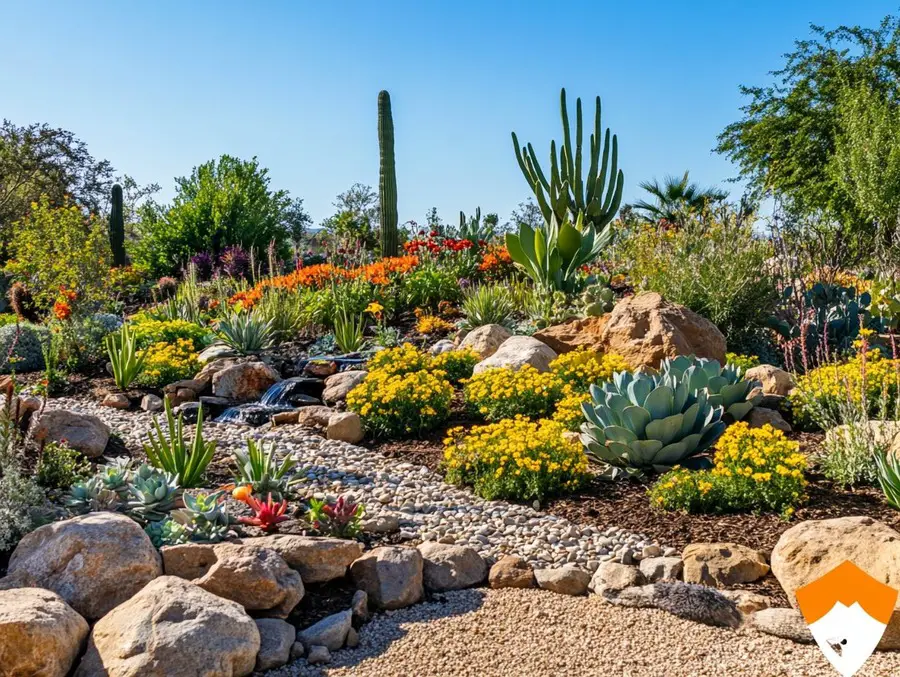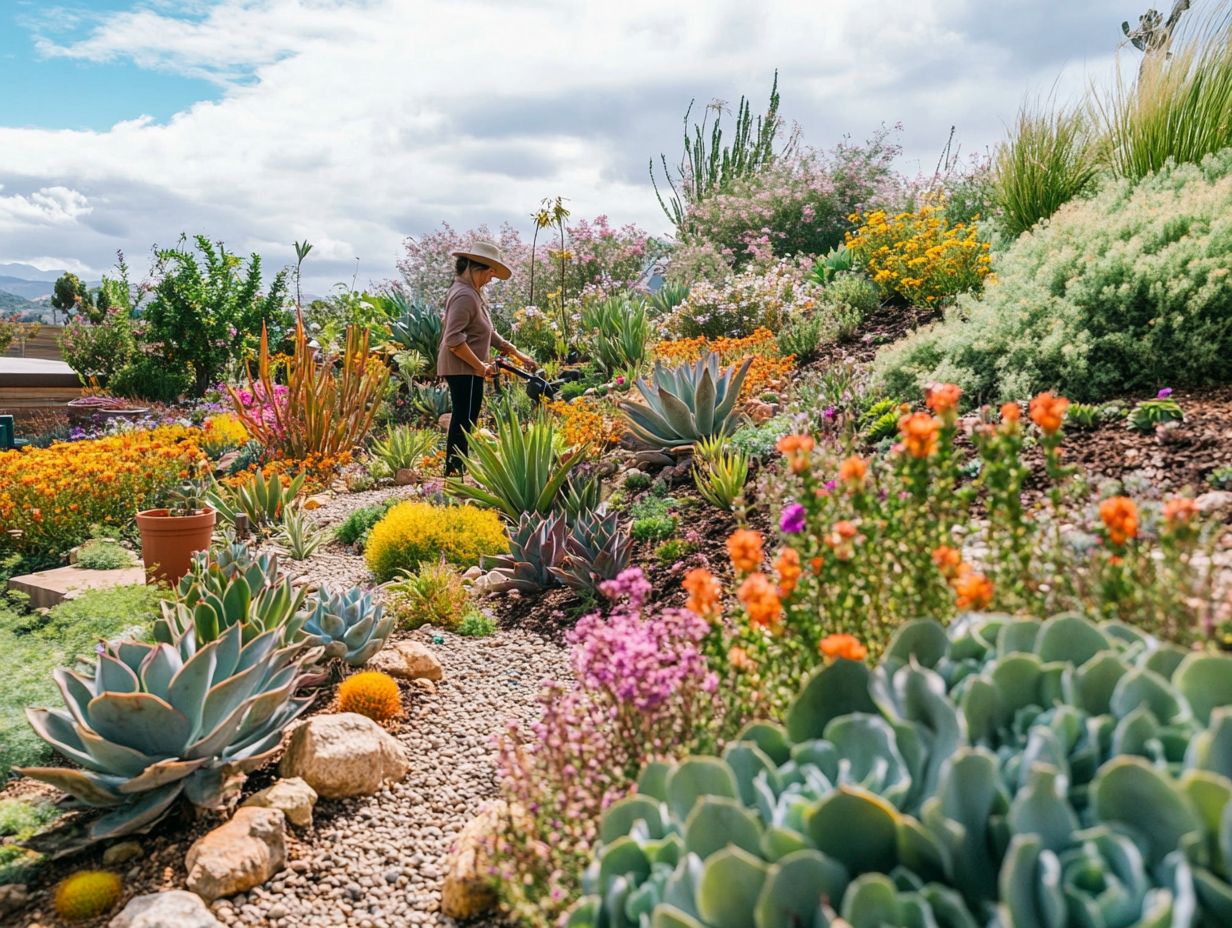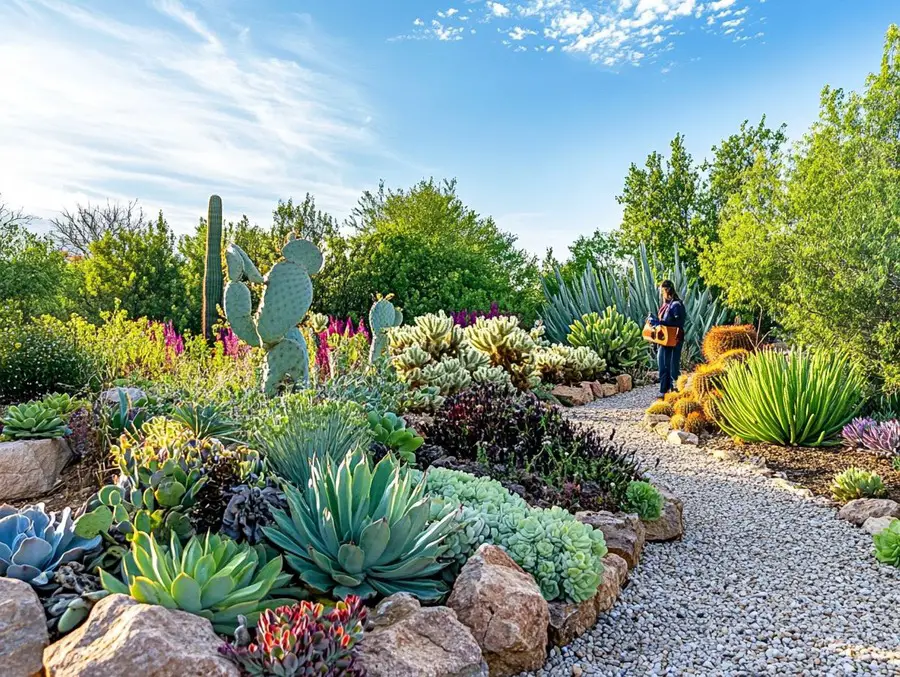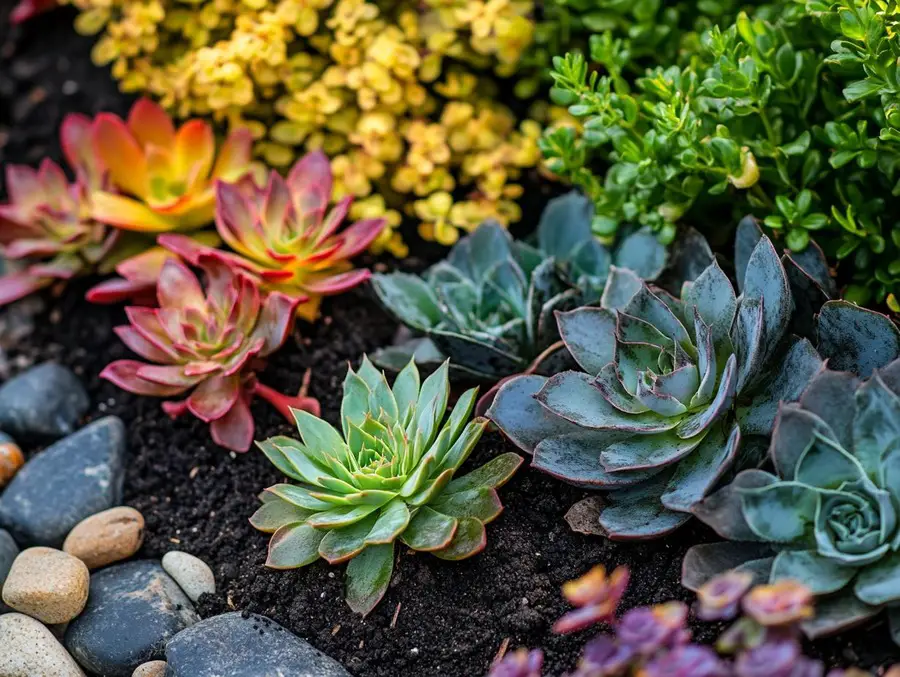We use affiliate links. If you purchase something using one of these links, we may receive compensation or commission.
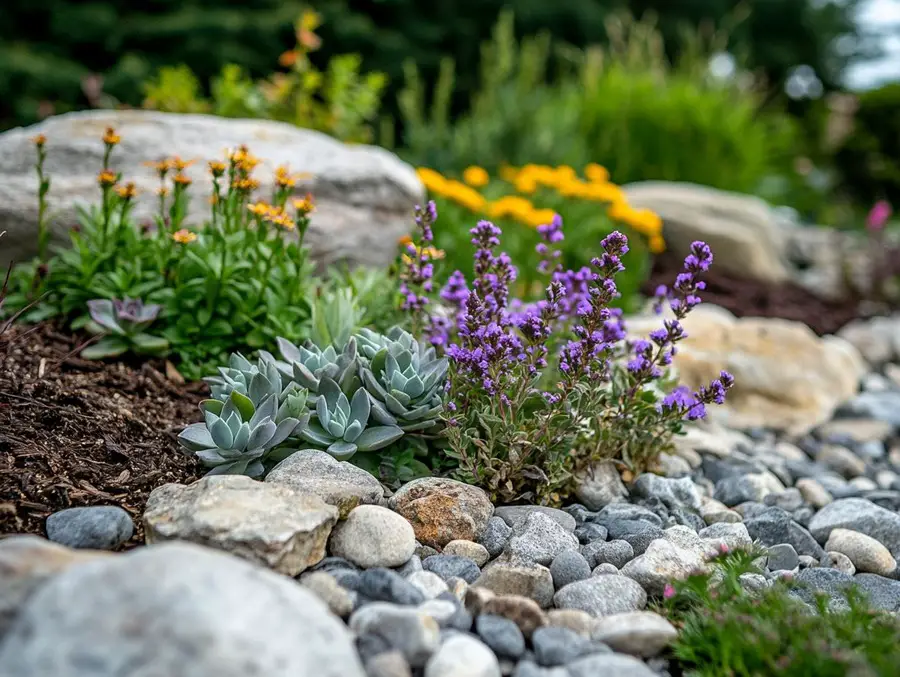
When you’re working with limited space, choosing the best plants for small xeriscapes can feel like a puzzle.
You want a lush, low-maintenance garden, but water restrictions and the wrong plants can make that tricky.
The good news? With the right drought-tolerant plants, you can create a stunning, eco-friendly xeriscape that thrives with minimal effort.
Plants for Small Xeriscapes Key Takeaways
- Plants for small xeriscapes include succulents like Blue Star Aloe, drought-tolerant wildflowers like Apache Plume, and ornamental grasses.
- These low-maintenance plants thrive with minimal water, add texture and color, and support biodiversity.
- Selecting native species ensures resilience and sustainability, making xeriscaping a smart, eco-friendly choice for small spaces.
Best Plants for Small Xeriscapes: Save Water, Maximize Beauty
Choosing the Best Plants for Small Xeriscapes is a clever gardening approach that helps you save water while creating vibrant outdoor spaces.
In this article, you’ll explore the essentials of xeriscaping, starting with what it is and the benefits it brings.
You’ll get guidance on picking the right plants for your small xeriscapes, taking into account all the factors that might influence your choices.
You’ll also discover design tips to craft a stunning xeriscape garden and learn some efficient maintenance techniques to keep your space thriving.
Plus, you’ll find solutions to common challenges, making xeriscaping both enjoyable and sustainable for you.
What is Xeriscaping?
.jpg_00.jpeg)
Xeriscaping is a landscaping method that helps you cut down or even ditch the need for irrigation by using drought-tolerant plants and smart garden design.
This approach is especially handy in areas where water is scarce, letting you create stunning, sustainable outdoor spaces that can flourish even in tough conditions.
By choosing plants like native species, succulents, cacti, and ornamental grasses, you can promote water efficiency while boosting biodiversity and crafting visually appealing gardens.
Xeriscaping Benefits
Xeriscaping is all about creating beautiful landscapes that need minimal irrigation, which is super important in areas that face drought and water scarcity.
This gardening approach encourages you to carefully choose plants that thrive in your local climate, helping them adapt and retain soil moisture effectively.
By opting for native species and drought-resistant varieties, you can create a vibrant garden that not only thrives on less water but also cuts down on the maintenance you have to do as a homeowner.
Mixing in various plant hardiness zones adds diversity to your garden, boosting its sustainability and making it more resilient against changes in the weather.
In the end, xeriscaping strikes a perfect balance between looking good and being environmentally responsible.
Choosing the Right Plants for Small Xeriscapes
When you’re choosing the right plants for your small xeriscape, it’s important to know which drought-tolerant and native plant varieties will thrive in your specific climate zone.
This way, you can create a vibrant and resilient garden that requires minimal maintenance.
Factors to Consider
When you’re picking plants for a small xeriscape, there are several factors you should keep in mind, like the soil composition, drainage, and the specific microclimates in your garden space.
These elements are key to ensuring the overall health and resilience of your plants.
For example, having the right soil moisture and drainage is crucial; it helps the roots get just the right amount of water and keeps root rot at bay.
Taking a look at plant heights and foliage texture can help you create a visually appealing arrangement too.
Taller plants can offer some much-needed shade for their shorter companions.
Plus, understanding how different species interact will help you choose the right companions, boosting biodiversity and making your xeriscape garden more sustainable.
So, by carefully considering these factors, you’ll set yourself up for a thriving and harmonious plant community.
Top Plant Picks for Small Xeriscapes
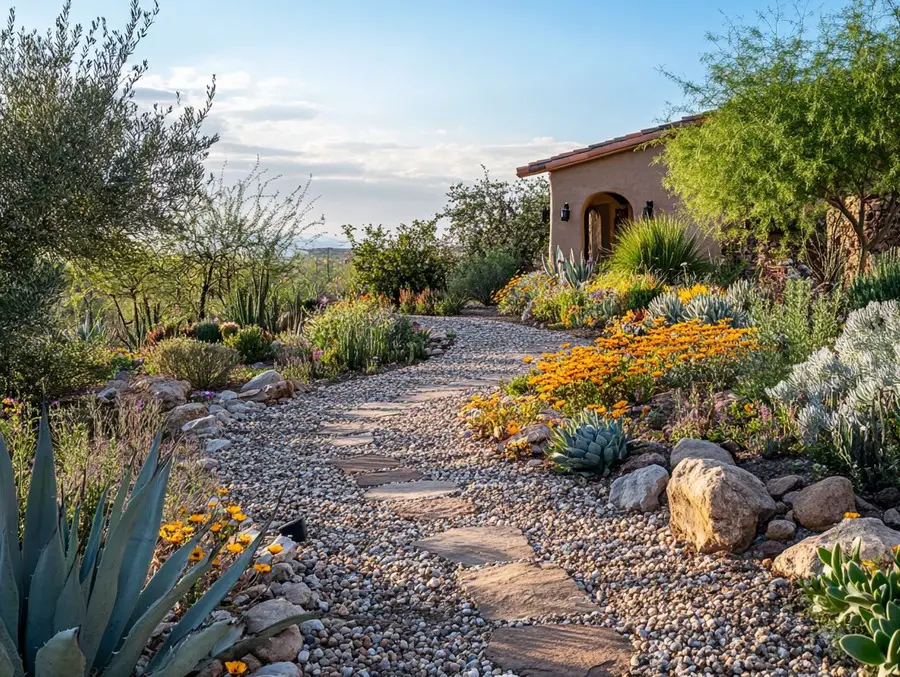
For your small xeriscape, some of the best plant picks include succulents, cacti, and native wildflowers.
They bring unique textures, colors, and seasonal interest to your space while being super low maintenance.
Take the Blue Star Aloe, for example. Its striking blue-gray foliage and impressive heat resistance make it a standout choice.
Then there’s the Golden Barrel Cactus, which adds a fun round shape and beautiful yellow blooms to your garden.
You might also consider the Apache Plume, a tough native wildflower that packs a punch with its vibrant colors and appeal to beneficial pollinators.
When you’re picking out plants, think about seasonal care.
Rotating and combining different varieties boosts the visual appeal and creates a dynamic ecosystem that can handle pests while keeping your landscape looking fresh and lively throughout the year.
Designing a Small Xeriscape Garden
When you’re designing a small xeriscape garden, it’s all about thoughtful planning that brings eco-scaping principles into play.
You want to make sure your landscape design is not just beautiful but also functional and sustainable.
Tips and Ideas for Layout and Aesthetics
To create an inviting layout in your small xeriscape garden, think about tips on plant spacing, using garden borders, and incorporating decorative stones to amp up the aesthetics.
By carefully selecting plants of different heights, you can add visual interest that guides the eye and highlights specific areas of your garden.
Brightly colored blooms can be lively focal points, while contrasting textures—like the softness of ornamental grasses against the ruggedness of stones—bring depth to your design.
Introducing elements like rock gardens or strategically placed containers can help you maximize space while letting your creativity shine.
Not only do these features cut down on water use, but they also boost the overall attractiveness of your garden, turning it into a serene retreat you’ll love to spend time in.
Maintenance and Care for Small Xeriscapes
You’ll find that keeping a small xeriscape garden is both easy and efficient.
It really focuses on seasonal care practices that boost plant health while helping you minimize water usage.
Smart irrigation systems and applying mulch are key strategies to make it all work smoothly.
Easy and Efficient Techniques
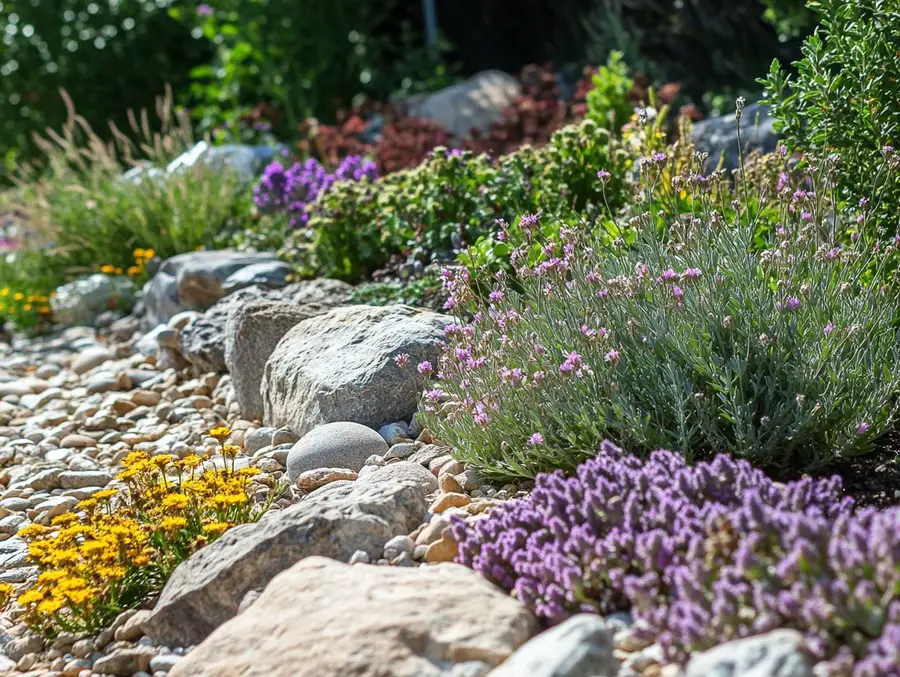
Implementing easy and efficient techniques for maintaining your small xeriscape can really boost your soil quality and moisture retention, helping your plants stay healthy and vibrant.
You might want to start by incorporating practices like composting, which enriches your soil and provides essential nutrients for robust growth.
Using organic soil amendments, such as aged manure or worm castings, can also work wonders by improving soil structure and helping it retain moisture longer.
This means you can cut back on those chemical fertilizers.
Regarding pest management, consider employing beneficial insects or whipping up some homemade sprays with garlic or neem oil.
These methods can keep those unwanted critters at bay without causing harm to your ecosystem.
Regularly checking your soil moisture levels will allow you to adjust your watering techniques just in time, ensuring your plants thrive, even during those dry spells.
This holistic approach to gardening not only supports your plants’ resilience but also fosters a more sustainable environment.
Potential Challenges and Solutions
Even though small xeriscapes are pretty resilient, they can still run into some challenges, like drought conditions or pesky insects.
But don’t worry—by choosing the right plant combinations and care strategies, you can find good solutions.
These gardens are designed to thrive with minimal irrigation, but they might feel a bit stressed when the temperatures rise or when there’s not enough rainfall.
Pests can also throw a wrench into the delicate ecosystem.
To tackle these issues, you should focus on plant diversity, mixing in a variety of native species that are well-suited to your local environment.
This not only helps your garden stand strong against pests but also allows the plants to support each other, resulting in a healthier garden overall.
By keeping an eye on things and using pest prevention tactics, like bringing in beneficial insects, you can further protect your landscape.
This way, you’ll be well on your way to creating a thriving xeriscape.
Best Plants for Small Xeriscapes FAQs
What are the best plants for a small xeriscape?
Some great options for small xeriscapes include succulents, lavender, yarrow, and ornamental grasses.
Do I need to water xeriscape plants frequently?
No, xeriscape plants are specifically chosen for their low water needs, so you won’t need to water them as often as other types of plants.
Can I grow vegetables in a small xeriscape?
Yes, there are many vegetables that are well-suited for xeriscapes, such as tomatoes, peppers, and herbs like thyme and oregano.
How can I add color to a small xeriscape?
You can incorporate colorful flowering plants like coneflowers, black-eyed susans, and yarrow, as well as brightly-hued succulents like aeonium and echeveria.
Are there any plants that do well in both dry and humid conditions?
Yes, certain plants like agave, sedum, and cacti are adaptable to both dry and humid environments, making them great for small xeriscapes in any climate.
Can I still have a variety of plant types in a small xeriscape?
Absolutely! You can mix and match plants with different heights, textures, and colors to add interest and diversity to your small xeriscape.
Xeriscape Garden Design & Layout: Easy Water-Wise Beauty
Best Plants for Xeriscape Gardens: Hardy & Beautiful
Xeriscape Garden Styles: Easy Low-Maintenance Options
Xeriscape Gardening Techniques: Easy Low-Water Tips
What is xeriscaping? A beginner’s guide to drought-tolerant landscaping – Colorado State University
Related Content
Visit my Amazon Influencer Page for videos and gardening products Grow Your Own Garden


